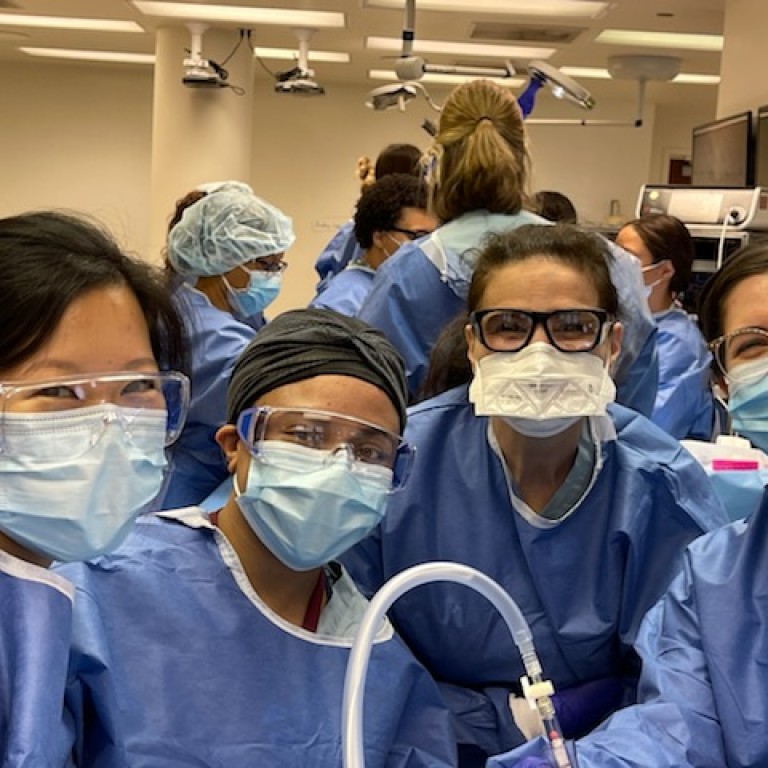Research Summary:
The Rana Preeclampsia Laboratory’s long-term goal is to contribute to the reduction, if not the elimination, of the terrible outcomes associated with preeclampsia.
Our laboratory primarily investigates the use of angiogenic biomarkers for the prediction of preeclampsia-related adverse maternal and fetal outcomes (AJOG, 2020). We believe that these biomarkers can be used for the risk stratification of patients with hypertensive disorders of pregnancy, especially when measured in the third trimester. This may help prevent unnecessary iatrogenic preterm deliveries and allow the allocation of scarce resources to patients with the most severe disease in low-resource settings. While studying the role of two of these biomarkers (sFlt1 and PlGF) in differentiating between preeclampsia and other hypertensive disorders, we discovered that they are excellent predictors of adverse outcomes related to preeclampsia and, therefore, could be used for the stratification of high-risk patients (Circulation, 2012; HTN, 2019). Recently, we showed that these biomarkers are altered in women with intrauterine growth restriction, putting them at risk for developing preeclampsia (Am J Obstet Gynecol MFM, 2021). In a study conducted in India, we showed that angiogenic factors may have utility in low-resource outpatient settings for women with hypertensive disease. Low sFlt1/PlGF levels were associated with a longer latency to delivery and no maternal complications (Pregnancy HTN, 2021). Based on our research, and that of others, these assays are now approved for clinical use in Europe. Studies are ongoing to evaluate clinical utility of biomarkers in the United States.
Our research also extended to Hôpital Albert Schweitzer (HAS) in Haiti, which has some of the world’s highest rates of preeclampsia-related maternal and fetal/neonatal mortality. Our early studies revealed that the current diagnostic criteria for preeclampsia poorly predicted adverse outcomes in Haiti (Raghuraman N, Pregnancy Hypertens. 2014), and that angiogenic factors are closely related to adverse outcomes associated with preeclampsia regardless of gestational age (March MI, PLoS One. 2015). We are testing whether novel angiogenic biomarkers are superior in predicting adverse outcomes, leading to dramatic reductions in maternal and fetal mortality related to preeclampsia.
Working with cardiologists, we discovered that the environment of late pregnancy is anti-angiogenic and that preeclampsia is accompanied by subclinical cardiac dysfunction, the extent of which correlates with circulating levels of sFlt1 and Activin (Nature, 2012; HTN 2016, 2018; JAHA 2020). Furthermore, we found that these changes persist several years after delivery (JAHA, 2021). We are currently conducting studies to evaluate strategies to mitigate the risk of cardiovascular disease among women with preeclampsia.
To evaluate novel upstream pathways that regulate placental sFlt1 production as a possible treatment for preeclampsia, the Rana lab has been screening FDA-approved and natural compounds using placental cell lines and small animals. In collaboration with Granger’s lab, we published a report demonstrating that Ouabain inhibits placental sFlt1 production by repressing the HSP27-dependent HIF-1α pathway (FASEB J, 2014). We recently found that luteolin (flavonoid) promotes vasorelaxation of uterine arteries during normal pregnancy (Pregnancy HTN, 2021).
Our mission to improve outcomes for women with hypertension has led to an interest in identifying and decreasing racial disparities in pregnancy outcomes. Our group used a large national dataset to examine racial differences in maternal comorbidities, peripartum characteristics, and maternal and fetal outcomes in women with preeclampsia/eclampsia. Our findings indicated that African American women with preeclampsia/eclampsia are more likely to have risk factors for this disease and more likely to suffer adverse outcomes during peripartum care (Hypertens Pregnancy, 2015). To reduce the morbidity related to preeclampsia at the University of Chicago, we established a program called STAMPP-HTN (Systematic Treatment and Management of Postpartum Hypertension). This collaborative has multiple interventions including improvement in education for patients and staff through video learning, written discharge instructions and printed educational material that is given to all patients, free BP monitors, follow-up in a postpartum hypertension clinic specifically designed for these patients, and long-term follow-up care in a cardiology clinic. This program has shown great success in increasing postpartum follow-up adherence among these patients and our findings were recently published in Obstetrics and Gynecology, 2021. Furthermore, we have now expanded the program to remote patient monitoring and the use of home blood pressure monitoring. We are currently evaluating if the use of technology will reduce disparity in care for African American women and improve maternal and fetal outcomes.
Current research:
Use of angiogenic biomarkers for prediction of adverse outcomes among women with suspected preeclampsia
Preeclampsia and risk of cardiovascular disease
Use of small molecules that inhibit sFlt1 as a potential treatment of preeclampsia
Systematic Treatment and Management of Postpartum Hypertension
Notable Rana Lab Publications
Verlohren S, Brennecke SP, Galindo A, Karumanchi SA, Mirkovic LB, Schlembach D, Stepan H, Vatish M, Zeisler H, Rana S. Clinical interpretation and implementation of the sFlt-1/ PlGF ratio in the prediction, diagnosis and management of preeclampsia and related disorders. Pregnancy Hypertens. 2021 Dec 8;27:42-50. PMID: 34915395. | Suresh S, Duncan C, Kaur H, Mueller AM, Tung A, Perdigao JL, Khosla K, Dhir R, Stewart K, Wallace K, Ahn R, Rana S. Postpartum Outcomes with Systematic Treatment and Management of Postpartum Hypertension (STAMPP HTN). Obstet Gynecol. 2021 Nov 1;138(5):777-787. PMID: 34619718. |
DeMartelly VA, Dreixler J, Tung A, Mueller AM, Heimberger S, Fazal A, Naseem H, Lang R, Kruse E, Yamat M, Granger JP, Bhavisha B, Rodriquez-Kovacs J, Rana S, Shahul S. Long-Term postpartum cardiac dysfunction among women with preeclampsia. J Am Heart Assoc. 2021 Feb;10(5):e018526. PMID: 33619970. | Soundararajan R, Suresh S, Mueller A, Heimberger S, Sathyanarayana C, Mahesh S, Madhuprakash S, Rana S. Real Life Outpatient Biomarker Use in Management of Hypertensive Pregnancies in third trimester in a Low Resource SeTting: ROBUST Study. Pregnancy Hypertens. 2020 Dec 3;23:97-103. PMID: 33307400.
|
Rana S, Burke SD, Karumanchi SA. Imbalances in circulating angiogenic factors in the pathophysiology of preeclampsia and related disorders. AJOG, 2020 Oct. PMID: 33096092. | Yang W, Li Q, Duncan JW, Bakrania BA, Bradshaw JL, Granger JP, Rana S, Spradley FT. Luteolin-induced vasorelaxation in uterine arteries from normal pregnant rats. Pregnancy Hypertens. 2020 Oct 23;23:11-17. PMID: 33161224. |
Suresh S, Mueller AM, Salahuddin S, Naseem H, Dhir R, Rana S. Evaluation of Angiogenic Factors in the Decision to Admit Women With Suspected Preeclampsia. Pregnancy Hypertens. 2020 Jul; 21:124-131. PMID: 32505096. | Lopes Perdigao J, Chinthala S, Mueller A, Minhas R, Ramadan H, Nasim R, Naseem H, Young D, Shahul S, Chan SL, Yeo KJ, Rana S. Angiogenic Factor Estimation as a Warning Sign of Preeclampsia-Related Peripartum Morbidity Among Hospitalized Patients. Hypertension. 2019 Apr; 73(4):868-877. PMID: 30798660. Selected as high Impact paper in HTN, summer 2019. |
Shahul S, Ramadan H, Nizamuddin J, Mueller A, Patel V, Dreixler J, Tung A, Lang RM, Weinert L, Nasim R, Chinthala S, Rana S. Activin A and Late Postpartum Cardiac Dysfunction Among Women with Hypertensive Disorders of Pregnancy. Hypertension. 2018 Jul;72(1):188-193. PMID: 29844146. Editor’s Choice, 2019. | Rana S, Powe CE, Salahuddin S, Verlohren S, Perschel FH, Levine RJ, Lim KH, Wenger JB, Thadhani R, Karumanchi SA. Angiogenic Factors and the Risk of Adverse Outcomes in Women with Suspected Preeclampsia. Circulation. 2012 Feb; 125(7): 911-9. PMID: 22261192. |

Sarosh Rana, MD, MPH, FACOG
Professor of Obstetrics and Gynecology , Section Chief of Maternal-Fetal Medicine

















